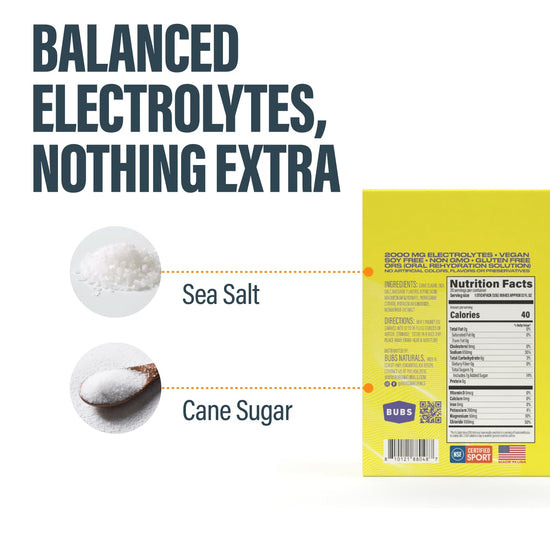Table of Contents
- Introduction
- The Basics: What Are Electrolytes?
- Himalayan Salt: A Closer Look
- Benefits of Using Himalayan Salt
- How to Incorporate Himalayan Salt into Your Diet
- Comparing Himalayan Salt to Other Sources of Electrolytes
- Conclusion
When we think about electrolytes, our minds often jump to sports drinks and electrolyte powders. But what if we told you that a simple kitchen staple, Himalayan salt, could also offer a natural source of these essential minerals? As wellness enthusiasts, we at BUBS Naturals are excited to dive deep into this topic and explore whether Himalayan salt truly holds its own as a good source of electrolytes.
Introduction
Electrolytes are crucial for maintaining hydration, nerve function, and muscle contractions. They include essential minerals such as sodium, potassium, calcium, and magnesium. But with so many sources available, it’s worth asking: can Himalayan salt—known for its vibrant pink hue and mineral-rich composition—serve as a reliable source of these electrolytes?
Himalayan salt is harvested from ancient sea salt deposits in the Himalayan mountains, and it's touted not only for its distinct flavor but also for its purported health benefits. It contains over 80 trace minerals, including those that play a role in hydration and overall wellness. However, the key question remains: does it contain enough of these minerals to make a significant impact on our electrolyte balance?
In this blog post, we will explore the composition of Himalayan salt, its electrolyte content, and how it compares to other sources of electrolytes. We will also discuss how we can incorporate Himalayan salt into our diets for optimal health and hydration. By the end of this article, we hope you'll have a clearer understanding of whether Himalayan salt is a good source of electrolytes and how it can fit into your wellness journey.
The Basics: What Are Electrolytes?
Electrolytes are minerals that exist in our bodies in ionic form and are vital for various physiological functions. Here are some of their primary roles:
- Hydration Regulation: Electrolytes help maintain fluid balance in and out of cells, tissues, and organs.
- Muscle Function: They are essential for muscle contractions. A deficiency can lead to cramps and weakness.
- Nerve Impulses: Electrolytes facilitate the transmission of nerve signals, allowing for communication between the brain and the body.
- Acid-Base Balance: They play a crucial role in maintaining the body's pH level, which is essential for metabolic processes.
Common electrolytes include sodium, potassium, calcium, magnesium, chloride, bicarbonate, and phosphate. While we often rely on sports drinks or supplements to replenish them, natural sources can be just as effective.
Himalayan Salt: A Closer Look
Himalayan salt, often referred to as pink salt, is mined from salt deposits formed millions of years ago from ancient oceans. Its distinctive pink color comes from the trace minerals it contains, such as iron oxide. These minerals give Himalayan salt its unique flavor and potential nutritional benefits.
Composition of Himalayan Salt
While Himalayan salt is primarily composed of sodium chloride (about 98%), it boasts a wealth of trace minerals, including:
- Calcium
- Potassium
- Magnesium
- Iron
- Zinc
- Copper
The exact mineral composition can vary based on the source and processing method. However, it’s estimated that Himalayan salt contains up to 84 different minerals and elements, contributing to its reputation as a healthier alternative to table salt.
Electrolyte Content in Himalayan Salt
So, what does the electrolyte content look like? Below is a general approximation of the electrolyte content per gram of Himalayan salt:
- Sodium: Approximately 368 mg
- Potassium: Approximately 3 mg
- Calcium: Approximately 1 mg
- Magnesium: Approximately 0.1 mg
It's important to note that while Himalayan salt contains these electrolytes, the concentrations are relatively low compared to other sources. For instance, an average sports drink might contain significantly higher levels of sodium and potassium per serving.
Benefits of Using Himalayan Salt
1. Natural Source of Electrolytes
For those seeking a natural way to replenish electrolytes, Himalayan salt can provide a mild source. It can be especially beneficial for individuals looking to reduce processed sugar intake from conventional sports drinks. We at BUBS Naturals appreciate the value of simple, clean ingredients, and Himalayan salt fits that philosophy nicely.
2. Flavor Enhancement
Himalayan salt can enhance the flavor of food without the need for excessive amounts. This can encourage individuals to consume more nutrient-dense foods, which can ultimately support better hydration and electrolyte balance.
3. Mineral-Rich Alternative
For individuals who may not be getting enough trace minerals in their diet, incorporating Himalayan salt can help in a small way. While it shouldn’t be relied upon as the primary source, it can complement a balanced diet rich in fruits, vegetables, and whole foods.
How to Incorporate Himalayan Salt into Your Diet
Incorporating Himalayan salt into your diet is easy and versatile. Here are some ideas:
- Cooking: Use Himalayan salt in your cooking as a seasoning for meats, vegetables, and grains. Its unique flavor can elevate your dishes.
- Salads: Sprinkle it on salads as a finishing touch to enhance flavor while adding trace minerals.
- Hydration: Try adding a pinch of Himalayan salt to your water or homemade electrolyte drinks. This can help with hydration, especially after exercise.
- Seasoning Blends: Combine it with herbs and spices for a flavorful seasoning blend.
At BUBS Naturals, we believe in a holistic approach to wellness. Our products, like our Hydrate Electrolytes, can complement your electrolyte needs, especially during and after intense physical activity.
Comparing Himalayan Salt to Other Sources of Electrolytes
While Himalayan salt does contain some electrolytes, how does it stack up against other popular sources?
- Coconut Water: Known for its high potassium content, coconut water is a fantastic natural source for replenishing electrolytes after exercise.
- Sports Drinks: These are specifically formulated to provide quick replenishment of electrolytes, often containing higher amounts of sodium and potassium than Himalayan salt.
- Fruits and Vegetables: Foods such as bananas, avocados, and leafy greens are excellent sources of essential electrolytes and should be included in a balanced diet.
While Himalayan salt can provide some electrolytes, it should be seen as a supplementary source rather than a primary one. Incorporating a variety of foods that are rich in electrolytes will ensure you maintain a balanced intake.
Conclusion
In conclusion, Himalayan salt does contain electrolytes, making it a potential natural source for electrolyte replenishment. However, while it offers trace amounts of essential minerals, it may not provide sufficient quantities to meet your electrolyte needs on its own. For optimal hydration and wellness, we recommend combining Himalayan salt with other natural sources such as fruits, vegetables, and our Hydrate Electrolytes.
As we navigate our wellness journeys together, let’s make informed choices that prioritize our health while honoring the legacy of Glen “BUB” Doherty, who inspired us to live adventurously and purposefully.
FAQ
Q: Does Himalayan salt have electrolytes?
A: Yes, Himalayan salt contains electrolytes such as sodium, potassium, calcium, and magnesium, albeit in relatively low concentrations.
Q: How does Himalayan salt compare to traditional table salt?
A: Himalayan salt contains trace minerals that are not present in regular table salt. However, both are primarily sodium chloride, and their health effects are generally similar.
Q: Can I rely on Himalayan salt alone for my electrolyte needs?
A: While Himalayan salt can contribute to your electrolyte intake, it should not be relied upon exclusively. A balanced diet including fruits, vegetables, and other electrolyte-rich foods is essential.
Q: What are the best natural sources of electrolytes?
A: Some of the best natural sources include coconut water, bananas, avocados, leafy greens, and various sports drinks.
Q: How can I incorporate Himalayan salt into my diet?
A: You can use Himalayan salt as a seasoning in cooking, sprinkle it on salads, or add a pinch to your hydration drinks for added flavor and minerals.
Written by:
Bubs Naturals

Hydrate or Die
When you’re sweating hard—whether it’s from a tough workout, a long day in the sun, or just life—your body needs more than water to stay balanced and energized.
Hydrate or Die® delivers 2,000 mg of electrolytes in every serving to help you rehydrate faster, fight off fatigue, and keep going strong. That includes the right mix of sodium, potassium, and magnesium to support muscle function, prevent cramps, and maintain energy levels.
With a small dose of natural cane sugar to speed up absorption, this clean, easy-to-use powder is made for real performance—not just flavor.
Starts at $29.60
Shop

